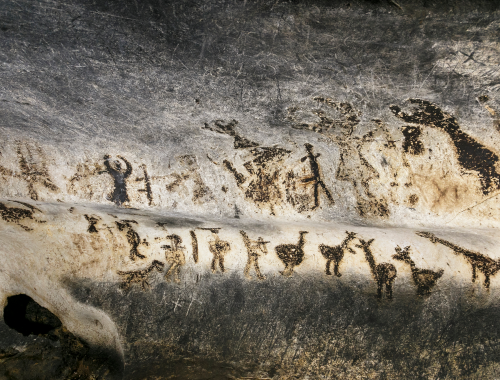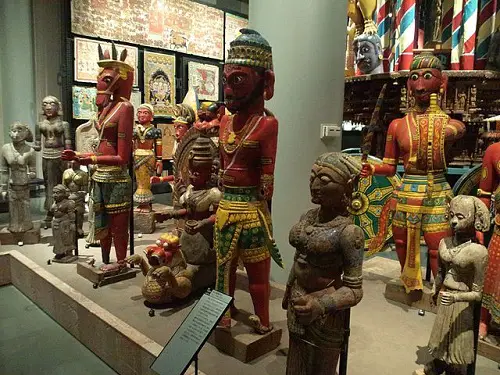
Forging Through Time: Common Ground in Neolithic and Paleolithic Eras
The Neolithic and Paleolithic eras stand as pivotal chapters in human history, marking significant milestones in the journey from ancient to modern civilizations. While these periods differ in many aspects, they share fundamental similarities that illuminate the resilience and adaptability of early human communities. This article delves into the common ground between the Neolithic and Paleolithic eras, exploring the threads that connect these epochs of human existence.

Hunter-Gatherer Lifestyle:
- Paleolithic: Both eras witnessed a predominantly hunter-gatherer lifestyle. Early humans relied on hunting game, fishing, and gathering edible plants for sustenance.
Use of Stone Tools:
- Paleolithic: Stone tools were integral to daily life, serving various purposes from hunting to crafting. Humans in the Paleolithic era crafted sophisticated tools using available materials.
- Neolithic: While tool technology evolved, stone tools continued to be essential in the Neolithic era, particularly in the early stages of agricultural development.
Nomadic Lifestyle:
- Paleolithic: Nomadism characterized the Paleolithic era, as humans moved in search of food sources. This mobile lifestyle shaped early social structures and cultural practices.
- Neolithic: The transition to settled agriculture was gradual, and early Neolithic communities often maintained semi-nomadic practices before establishing more permanent settlements.
Artistic Expression:
- Paleolithic: Cave paintings and carvings, such as those found in Lascaux and Altamira, showcase the artistic expression of Paleolithic humans. These artworks depicted animals, scenes from daily life, and possibly spiritual beliefs.
- Neolithic: Artistic expression continued in the Neolithic era with pottery, sculptures, and mural paintings. Themes shifted to reflect the agricultural lifestyle, including depictions of domesticated animals and farming activities.
Social Structures:
- Paleolithic: Early human groups in the Paleolithic era operated in small, kin-based communities. Social structures were likely egalitarian, with communal sharing of resources.
- Neolithic: The shift to agriculture brought about more complex social structures. Settlements grew, and social hierarchies emerged as surplus food allowed for specialized roles within communities.
Spiritual Beliefs:
- Paleolithic: Evidence suggests that Paleolithic humans had spiritual beliefs, as seen in burial practices and the presence of symbolic artifacts. The natural world and animals held spiritual significance.
- Neolithic: Spiritual beliefs continued to evolve, and the transition to agriculture may have influenced the development of more organized religious practices. Ritualistic sites and monuments, like Stonehenge, point to spiritual engagement.
Adaptation to Environmental Challenges:
Paleolithic: Early humans in the Paleolithic era demonstrated adaptability to diverse environments, from icy tundras to temperate forests. Survival hinged on an intimate understanding of local ecosystems.
Neolithic: Agricultural practices in the Neolithic era reflected adaptation to specific environmental conditions. Domestication of plants and animals allowed humans to thrive in varied landscapes.
Development of Language:
- Paleolithic: While direct evidence is scarce, it is believed that early humans in the Paleolithic era communicated through language. This tool was crucial for cooperation, hunting, and passing on knowledge.
- Neolithic: Language continued to be a fundamental aspect of human interaction. As societies grew more complex, language played a key role in coordinating agricultural activities and fostering community ties.
Technological Innovation:
- Paleolithic: Paleolithic humans displayed remarkable technological innovation in crafting stone tools, demonstrating an advanced understanding of materials and techniques.
- Neolithic: The Neolithic era witnessed further technological advancements with the development of polished stone tools, pottery, and later, metalworking.
The Neolithic and Paleolithic eras share core elements that underscore the resilience, adaptability, and creativity of early human communities. While each era brought distinct changes and innovations, the commonalities highlight the enduring characteristics that shaped the course of human history.
Here’s a simplified comparison table highlighting the commonalities between the Neolithic and Paleolithic eras:
| Aspect | Paleolithic Era | Neolithic Era |
| Lifestyle | Predominantly hunter-gatherer. | Transition from hunter-gatherer to settled agriculture. |
| Stone Tools | Essential; sophisticated tools crafted from stone. | Continued use of stone tools; evolution in tool technology. |
| Nomadic Lifestyle | Nomadic, moving in search of food sources. | Transition from nomadic to settled, semi-nomadic in early stages. |
| Artistic Expression | Cave paintings, carvings depicting daily life. | Pottery, sculptures, mural paintings reflecting agricultural life. |
| Social Structures | Small, kin-based communities; likely egalitarian. | Growth in settlements, emergence of social hierarchies. |
| Spiritual Beliefs | Burial practices, symbolic artifacts; nature-centric beliefs. | Evolution of spiritual beliefs; ritualistic sites emerge. |
| Adaptation to Environment | Adaptable to diverse environments. | Agricultural practices reflect adaptation to specific landscapes. |
| Development of Language | Believed to communicate through language. | Continued importance of language in complex societies. |
| Technological Innovation | Remarkable stone tool craftsmanship. | Advancements in polished stone tools, pottery, and later, metalworking. |
These commonalities provide a snapshot of the shared features between the Paleolithic and Neolithic eras, showcasing the continuity and evolution of human civilization.
FAQ: Similarities Between Neolithic and Paleolithic Eras
Q1: Were early humans in both the Paleolithic and Neolithic eras primarily hunter-gatherers?
A1: Yes, both eras saw the predominance of a hunter-gatherer lifestyle, where early humans relied on hunting, gathering, and fishing for sustenance.
Q2: Did stone tools play a crucial role in both eras?
A2: Absolutely. Stone tools were integral in both the Paleolithic and Neolithic periods. In the Paleolithic era, sophisticated tools were crafted for various purposes, and in the Neolithic era, stone tools continued to be essential, especially in the early stages of agricultural development.
Q3: Was there a nomadic lifestyle in both eras?
A3: Yes, the Paleolithic era was characterized by a nomadic lifestyle as early humans moved in search of food sources. In the Neolithic era, there was a gradual transition from nomadic to settled communities, though some societies maintained semi-nomadic practices initially.
Q4: Did artistic expression exist in both eras?
A4: Certainly. In the Paleolithic era, we see cave paintings and carvings depicting scenes from daily life and possibly spiritual beliefs. The Neolithic era continued artistic expression with pottery, sculptures, and mural paintings reflecting the agricultural way of life.
Q5: Were social structures similar in both eras?
A5: In the Paleolithic era, social structures were likely small, kin-based, and relatively egalitarian. The Neolithic era witnessed the growth of settlements and the emergence of more complex social hierarchies.
Q6: Were there similarities in spiritual beliefs between the two eras?
A6: Yes, both eras saw evidence of spiritual beliefs. In the Paleolithic era, this is reflected in burial practices and symbolic artifacts. The Neolithic era witnessed the evolution of spiritual beliefs with the emergence of ritualistic sites.
Q7: How did early humans in both eras adapt to their environments?
A7: Early humans in the Paleolithic era demonstrated adaptability to diverse environments, from icy tundras to temperate forests. In the Neolithic era, agricultural practices reflected adaptation to specific environmental conditions.
Q8: Was the development of language significant in both eras?
A8: Yes, language was likely crucial in both eras. In the Paleolithic era, it was a tool for cooperation, hunting, and passing on knowledge. In the Neolithic era, language continued to play a fundamental role in coordinating agricultural activities and fostering community ties.
Q9: Did technological innovation occur in both eras?
A9: Absolutely. In the Paleolithic era, humans displayed remarkable technological innovation in crafting sophisticated stone tools. In the Neolithic era, there were further advancements with the development of polished stone tools, pottery, and later, metalworking.
Q10: Were there similarities in the adaptation of early humans to different landscapes during both eras?
A10: Yes, early humans in both the Paleolithic and Neolithic eras demonstrated adaptability to diverse landscapes. In the Paleolithic era, this adaptability was crucial for survival in various environments, while in the Neolithic era, agricultural practices reflected adaptation to specific landscapes.
Q11: Did both eras witness the development of art and symbolic expression?
A11: Absolutely. The Paleolithic era is known for its cave paintings and carvings, showcasing artistic expression and possibly symbolic meanings. In the Neolithic era, artistic expression continued with pottery, sculptures, and mural paintings, reflecting the evolving cultural landscape.
Q12: How did social structures evolve from the Paleolithic to the Neolithic era?
A12: In the Paleolithic era, social structures were likely small and kin-based, with a relatively egalitarian structure. The Neolithic era witnessed the growth of settlements, leading to more complex social hierarchies as communities became larger and more organized.
Q13: Were there commonalities in the spiritual beliefs of early humans in both eras?
A13: Yes, both eras saw evidence of spiritual beliefs. In the Paleolithic era, this is reflected in burial practices and symbolic artifacts. In the Neolithic era, the evolution of spiritual beliefs is evident through the emergence of ritualistic sites and monuments.
Q14: Did both eras experience a transition in lifestyle and settlement patterns?
A14: Yes, there was a transition in lifestyle and settlement patterns from the Paleolithic to the Neolithic era. The shift from a nomadic hunter-gatherer lifestyle to settled agriculture marked a significant change in human societies.
Q15: Were stone tools continuously used in the Neolithic era?
A15: Yes, while tool technology evolved, stone tools continued to be essential in the Neolithic era, especially in the early stages of agricultural development.
Q16: Did language remain a crucial aspect of communication in the Neolithic era?
A16: Yes, language continued to be fundamental in the Neolithic era. It played a key role in coordinating agricultural activities, facilitating communication within communities, and passing on knowledge.












Leave a Reply